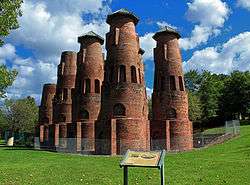Coplay, Pennsylvania
Coplay is a borough in Lehigh County, Pennsylvania, six miles (10 km) northwest of Allentown. It is part of the Lehigh Valley region of the state. In 1900, 1,581 people lived in Coplay; in 1910, 2,670 people lived there. The population was 3,192 at the 2010 census. Coplay is included in the Allentown-Bethlehem-Easton, PA-NJ Metropolitan Statistical Area, which is also included in the New York City-Newark, New Jersey, NY-NJ-CT-PA Combined Statistical Area.
Coplay, Pennsylvania | |
|---|---|
 Coplay Cement Company Kilns in Saylor Park | |
 Location of Coplay in Lehigh County, Pennsylvania. | |
 Coplay Location of Coplay in Pennsylvania  Coplay Coplay (the United States) | |
| Coordinates: 40°40′14″N 75°29′43″W | |
| Country | United States |
| State | Pennsylvania |
| County | Lehigh |
| Area | |
| • Total | 0.63 sq mi (1.62 km2) |
| • Land | 0.61 sq mi (1.58 km2) |
| • Water | 0.02 sq mi (0.04 km2) |
| Elevation | 400 ft (100 m) |
| Population (2010) | |
| • Total | 3,192 |
| • Estimate (2019)[2] | 3,214 |
| • Density | 5,268.85/sq mi (2,033.32/km2) |
| Time zone | UTC-5 (EST) |
| • Summer (DST) | UTC-4 (EDT) |
| ZIP code | 18037 |
| Area code(s) | 610 and 484 |
| FIPS code | 42-16128 |
| Website | www |
Geography
Coplay is located at 40°40′14″N 75°29′43″W (40.670521, -75.495395).[3]
According to the United States Census Bureau, the borough has a total area of 0.6 square miles (1.6 km2), of which, 0.6 square miles (1.6 km2) of it is land and 0.04 square miles (0.10 km2) of it (3.08%) is water. The Borough of Coplay is situated along the Lehigh River, about 5 miles (8.0 km) north of Allentown.
History
Coplay was part of the 400 acres (1.6 km2) of land John Jacob Schreiber bought from the William Penn heirs in 1740. For a long time it was known as Schreibers. Later it was known as the Lehigh Valley, because of the Lehigh Valley Iron Furnaces that were located here. Lehigh Valley was then changed to Coplay. This name came from "Kolapechka". The son of the Indian chief, Paxanosa, who lived at the head of the creek near Schnecksville. The Borough of Coplay seceded from Whitehall Township in 1869 and was incorporated as a borough on April 7, 1869.
Gradually Coplay changed from a farming area into an Industrial Community. The Thomas Iron Company started the change. They brought in workers and built homes for them. When the Iron Company was liquidated, other industries gradually came to Coplay; the Cement Mill, the Silk Mill, the Cigar Factory and Knitting Mill.
Coplay became a "melting pot" of many nationalities. The Pennsylvania Dutch and Germans, who were the agricultural element. Due to growth of the Iron Industry, immigrants from Ireland came. Then, in the early 1900s, the Cement Mills attracted immigrants from Austria, Hungary, Czechoslovakia, Poland, and the Ukraine.
On April 7, 1969, the borough celebrated its centennial anniversary. A celebration was held from June 15–21 in the town.
The Coplay Cement Company Kilns was added to the National Register of Historic Places in 1980.[4]
Demographics
| Historical population | |||
|---|---|---|---|
| Census | Pop. | %± | |
| 1870 | 728 | — | |
| 1880 | 774 | 6.3% | |
| 1890 | 880 | 13.7% | |
| 1900 | 1,581 | 79.7% | |
| 1910 | 2,670 | 68.9% | |
| 1920 | 2,845 | 6.6% | |
| 1930 | 3,279 | 15.3% | |
| 1940 | 3,109 | −5.2% | |
| 1950 | 2,994 | −3.7% | |
| 1960 | 3,701 | 23.6% | |
| 1970 | 3,642 | −1.6% | |
| 1980 | 3,130 | −14.1% | |
| 1990 | 3,267 | 4.4% | |
| 2000 | 3,387 | 3.7% | |
| 2010 | 3,192 | −5.8% | |
| Est. 2019 | 3,214 | [2] | 0.7% |
| Sources:[5][6][7] | |||
As of the census[6] of 2000, there were 3,387 people, 1,431 households, and 953 families residing in the borough. The population density was 5,373.1 people per square mile (2,075.8/km²). There were 1,484 housing units at an average density of 2,354.2 per square mile (909.5/km²). The racial makeup of the borough was 96.84% White, 1.56% African American, 0.09% Native American, 0.32% Asian, 0.53% from other races, and 0.65% from two or more races. Hispanic or Latino of any race were 2.27% of the population. Coplay has one of the highest reported rates of Austrian ancestry in the United States, at 10.6%.[8]
There were 1,431 households, out of which 28.8% had children under the age of 18 living with them, 49.3% were married couples living together, 13.5% had a female householder with no husband present, and 33.4% were non-families. 29.3% of all households were made up of individuals, and 14.4% had someone living alone who was 65 years of age or older. The average household size was 2.34 and the average family size was 2.90.
In the borough the population was spread out, with 23.0% under the age of 18, 5.3% from 18 to 24, 29.9% from 25 to 44, 20.9% from 45 to 64, and 20.9% who were 65 years of age or older. The median age was 40 years. For every 100 females there were 86.2 males. For every 100 females age 18 and over, there were 83.3 males.
The median income for a household in the borough was $38,679, and the median income for a family was $46,278. Males had a median income of $31,519 versus $24,983 for females. The per capita income for the borough was $18,580. About 5.6% of families and 7.0% of the population were below the poverty line, including 13.8% of those under age 18 and 5.3% of those age 65 or over.
Education
The Borough of Coplay is served by the Whitehall-Coplay School District.
High School students who live in Coplay attend Whitehall High School, but there was at one time a Coplay High School. A building, which is now the Coplay Borough Hall and Police headquarters, was once the Washington School. Then in 1928, after expansions were made, the building at the corner of fourth and center streets became the Coplay High School. The last graduating class was in 1963, then Coplay School District joined the Whitehall School District to make the Whitehall-Coplay School District.
Christ the King school used to be located in Coplay, on the St. Peter's Roman Catholic Church grounds, until it merged with Our Lady of Hungary in Northampton. They merged before the 2011-2012 school year. The school serves for grades Pre-K to 8. The new school is named Good Shepherd Catholic School and is located in the old OLH school building in Northampton.
Borough Council Members
- Mayor - Dean Molitoris
- Council President - Louis Bodish
- Carl Luckenbach
- Steve Burker
- Dave Royer
- Janet Eisenhauer
- Mark Molitoris
- Charles Sodl
Notable People
- Saquon Barkley, former Penn State and current New York Giants running back.
References
- "2019 U.S. Gazetteer Files". United States Census Bureau. Retrieved July 28, 2020.
- "Population and Housing Unit Estimates". United States Census Bureau. May 24, 2020. Retrieved May 27, 2020.
- "US Gazetteer files: 2010, 2000, and 1990". United States Census Bureau. 2011-02-12. Retrieved 2011-04-23.
- "National Register Information System". National Register of Historic Places. National Park Service. July 9, 2010.
- "Census of Population and Housing". U.S. Census Bureau. Retrieved 11 December 2013.
- "U.S. Census website". United States Census Bureau. Retrieved 2008-01-31.
- "Incorporated Places and Minor Civil Divisions Datasets: Subcounty Resident Population Estimates: April 1, 2010 to July 1, 2012". Population Estimates. U.S. Census Bureau. Archived from the original on 11 June 2013. Retrieved 11 December 2013.
- "Ancestry Map of Austrian Communities". Epodunk.com. Archived from the original on 8 July 2008. Retrieved 2008-08-13.

